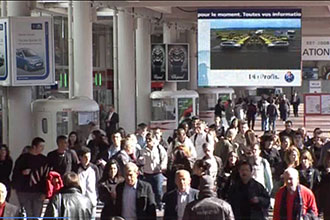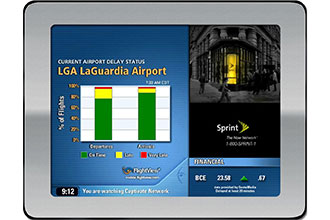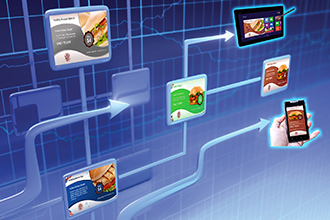Are Your Viewers In the Zone — Or Not?
 The focus of this series “Power of Content” is to help people with content strategies and how they relate to digital screen media.
The focus of this series “Power of Content” is to help people with content strategies and how they relate to digital screen media.
One fundamental question about displaying content on the screen goes back to the real estate analogy. Should there be a single structure taking up the whole display property, or is it better to subdivide and put something in two, three, or even more distinct areas? In digital signage, these screen areas are called zones.
Some networks will take the full area of a 16:9 screen and split it up into three areas: one that retains the 16:9 format, another next to it in the 4:3format, and a short, wide zone along the bottom of the 16:9 area (Figure 1.1). One would use the first zone for branding content, the second for informational or secondary ad content, and the third as a ticker.

Indeed, the question of how many zones to use — or whether to use any at all — often arises when a network will use data-driven content, such as news headlines, weather forecasts or stock prices.
Although at first the zone approach appears to deal with a number of issues — from providing a way to display the full images of content in multiple ratios to creating variety for the viewer — there is a fundamental question to ask (Figure 1.2). Is it preferable to display this content at all times or does that create a distraction that confuses the viewer or prevents the viewer from focusing on the revenue-generating content or the main message?
Another study clearly shows that doing so many different things at once can actually impair cognitive ability. In a 2009 study, Stanford researcher Clifford Nass challenged 262 college students to complete experiments that involved switching among tasks, filtering irrelevant information, and using working memory. Nass and his colleagues expected that frequent multitaskers would outperform non-multi-taskers on at least some of these activities.
They found the opposite: Chronic multitaskers were abysmal at all three tasks. The scariest part: Only one of the experiments actually involved multitasking, signaling to Nass that even when they focus on a single activity, frequent multitaskers use their brains less effectively.

This conundrum is not an easy one to solve, and the answer often depends on the type of network involved. So let’s look at a few types of networks that have zones and some that do not understand why the given choices are inappropriate.
NOT
As a rule Point Of Transit (POT) networks do not employ zones. Why not? Because the function of these screens as something akin to a live poster, combined with the limited time the viewer is exposed to them, means that a powerful message needs to be conveyed in just a few seconds. Advertisers understandably want full command of the screen so there is no interference with their message. Although the message on the screen will change periodically, at any given time there should not be any competition for the viewer’s attention from secondary zones.
There are occasions, however, where even a POT network can be more effective with zones, provided they are used in a creative manner. Keep in mind the issue of viewer relevancy. At an airport, weather and other information about a destination is of great interest to a viewer, and having such information displayed in a zone on the screen could attract and hold a viewer’s attention for a somewhat longer period of time, exposing the viewer to ads in the main zone. But it cannot be a moving ticker at the bottom or motion zone on the right or left. If it was a single text with weather Icons and with NO movement and it changed every 60 seconds, then this would not be distraction from the main message, and could attract the viewer and expose them to the main message. At the same time, the weather information could also be displayed full screen as part of a loop that also contains advertising like a convertible BMW on a sunny day. Care needs to be taken with such choices given the existence of several credible studies that suggest zones in POT networks do not work and detract from the message the advertiser is trying to get across.
NOT
Point of Sale (POS) Networks typically are driving a single message to purchase. We see zones used in this environment way too often. To the viewer who is surrounded by many products on the shelf a screen with zones becomes nothing but noise in the retail environment. Instead one zone should be used and the purpose should be to offer a helpful message that needs to say: “How can I help you buy this today?” POS networks need to understand their function. So many times we see ad related networks in a retail environment that has ads that are not relevant to the shopping there and now experience… but I digress. POS full screen one message at a time and interactive if possible is very effective.
IN THE ZONE
 One subset of Point of Wait (POW) networks that is amenable to the use of zones is the elevator network. Although there is still a limited amount of time to get a message across and a relatively small amount of screen real estate to do it, the fact is that the average person in an office building rides the elevator six times a day, and each ride lasts an average of 1 minute. This sort of network is ideal for presenting short bursts of content (15 seconds or so) in a few different zones on the screen. The viewer who chooses to focus on one zone during one ride may well choose another zone on the next ride, maintaining interest in the screen and making this approach a viable option for this type of network.
One subset of Point of Wait (POW) networks that is amenable to the use of zones is the elevator network. Although there is still a limited amount of time to get a message across and a relatively small amount of screen real estate to do it, the fact is that the average person in an office building rides the elevator six times a day, and each ride lasts an average of 1 minute. This sort of network is ideal for presenting short bursts of content (15 seconds or so) in a few different zones on the screen. The viewer who chooses to focus on one zone during one ride may well choose another zone on the next ride, maintaining interest in the screen and making this approach a viable option for this type of network.
The other subset is internal corporate communications (not lobby screens), where the viewer sees the same screen many many times. Zones here are very useful precisely because eliminating the chance for boredom is an important concern. These zones help keep the messaging fresh. Providing zones of information lets viewers focus on different parts of the screen because they are engaged frequently over a longer period of a week. In addition one can categorize the look and feel of each message type to cue in the viewer. Safety messages for example can have a yellow and black ICON to signify that his is a safety message. Then the viewer that is concerned about these issues will notice the messaging and pay attention to this subject matter.
With zones, keep in mind that it is all relevant to the mind-set of the viewer and the type of network. Viewers will ignore the screens if their mind-set and the type of network do not match the purpose of why the shopper, person with dwell time, or person on the go is in the venue in the first place.
 With changes in both content and technology, the perception of the viewer is becoming altered as well. Smart phones and tablets are part of our appendages, and are part of the tool kit of high school students. Digital signage is now that ubiquitous, and viewers are more accustomed to them and pay less attention to the screen on the wall. Continual evaluation is the only thing that will clarify how this element of digital signage will be perceived.
With changes in both content and technology, the perception of the viewer is becoming altered as well. Smart phones and tablets are part of our appendages, and are part of the tool kit of high school students. Digital signage is now that ubiquitous, and viewers are more accustomed to them and pay less attention to the screen on the wall. Continual evaluation is the only thing that will clarify how this element of digital signage will be perceived.
Author and speaker Keith Kelsen, chief visionary at 5th Screen, is considered one of the leading experts on digital media. More information about his book, Unleashing the Power of Digital Signage — Content Strategies for the 5th Screen, published by Focal Press, can be found on the book’s companion website at www.5thscreen.info. Reach him atkeith.kelsen@5thscreen.com or on Twitter.





